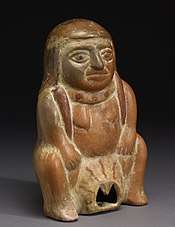Pain management during childbirth
| Pain management during childbirth | |
|---|---|
| Specialty | obstetrician |
Pain management during childbirth is the treatment or prevention of pain that a woman may experience during labor and delivery. The amount of pain a woman feels during labor depends partly on the size and position of her baby, the size of her pelvis, her emotions, the strength of the contractions, and her outlook.[1] Tension increases pain during labor.[2] Virtually all women worry about how they will cope with the pain of labor and delivery. Childbirth is different for each woman and predicting the amount of pain experienced during birth and delivery can not be certain.[1]
Some women do fine with "natural methods" of pain relief alone. Many women blend "natural methods" with medications and medical interventions that relieve pain. Building a positive outlook on childbirth and managing fear may also help some women cope with the pain. Labor pain is not like pain due to illness or injury. Instead, it is caused by contractions of the uterus that are pushing the baby down and out of the birth canal. In other words, labor pain has a purpose.[1]
Preparation
Preparation for childbirth can effect the amount of pain experienced during childbirth. It is possible to take a childbirth class, consult with those managing the pregnancy, and writing down questions can assist in getting the information that a woman needs to help manage pain. Simple interaction with friends and family can alleviate concerns.[1]
Non-pharmacological

Many methods help women to relax and make pain more manageable. These can be:
- breathing and relaxation techniques[1][3]
- warm showers or baths[1]
- massage[1][2]
- using heat and cold, such as heat on lower back and cold washcloth on forehead[1]
- Having the supportive care of a loved one, nurse, or doula[1] The presence of a doula or female attendant results in a decrease in need for pharmacological pain control.[4]
- changing positions while in labor (stand, crouch, sit, walk, etc.)[1]
- using a labor ball[1]
- listening to music[1]
- acupuncture[3]
Water and childbirth
According to the American Office of Women's Health, laboring in a tub of warm water, also called hydrotherapy, helps women feel physically supported, and keeps them warm and relaxed. It is also easier for laboring women to move and find comfortable positions in the water. In waterbirthing, a woman remains in the water for delivery. The American Academy of Pediatrics has expressed concerns about delivering in water because of a lack of studies showing its safety and because of the rare but reported chance of complications.[1]
Medical and pharmaceutical methods of pain control
Physicians, Nurse Practitioners, Physician Assistants, Nurses and Midwives will typically ask the woman in labor if there is a need of pain relief. Many pain relief options work well when given by a trained and experienced clinician. Clinicians also can use different methods for pain relief at different stages of labor. Still, not all options are available at every hospital and birthing center. Depending on the health history of the mother, the presence of allergies or other concerns, some choices will work better than others.[1]
There are many methods of relieving pain used for labor. Rare and unpredictable, serious complications sometimes occur. Also, most medicines used to manage pain during labor pass freely into the placenta to the baby. Asking questions about the procedures and medications which may affect the baby are valid questions.[1]
Opioids
These are also called narcotics and are medicines given through an IV or by injection into a muscle. Sometimes, opioids also are given with an epidural or a spinal block. Opioids can make the pain bearable, and don't affect the ability to push. Opioids don't get rid of all the pain. They
- are short-acting.
- cause drowsiness.
- cause nausea and vomiting.
- can cause itchiness.
- cannot be given right before delivery because they may slow the baby's breathing and heart rate at birth.[1]
Epidural and spinal blocks

An epidural is a procedure that involves placing a tube (catheter) into the lower back, into a small space below the spinal cord. Small doses of medicine can be given through the tube as needed throughout labor. With a spinal block, a small dose of medicine is given as a shot into the spinal fluid in the lower back. Spinal blocks usually are given only once during labor. Epidural and spinal blocks allow most women to be awake and alert with very little pain during labor and childbirth. With an epidural, pain relief starts 10 to 20 minutes after the medicine has been given. The degree of numbness felt can be adjusted. With spinal block, good pain relief starts right away, but it only lasts 1 to 2 hours.[1]
Although movement is possible, walking may not be if the medication affects motor function. An epidural can lower blood pressure, which can slow your baby's heartbeat. Fluids given through IV are given to lower this risk. Fluids can cause shivering. But women in labor often shiver with or without an epidural. If the covering of the spinal cord is punctured by the catheter, a bad headache may develop. Treatment can help the headache. An epidural can cause a backache that can occur for a few days after labor. An epidural can prolong the first and second stages of labor. If given late in labor or if too much medicine is used, it might be hard to push when the time comes. An epidural increases risk of assisted vaginal delivery.[1]
Pudendal block
In this procedure a doctor injects numbing medicine into the vagina and the nearby pudendal nerve. This nerve carries sensation to the lower part of the vagina and vulva. This method of pain control is only used late in labor, usually right before the baby's head comes out. With a pudendal block, there is some pain relief but the laboring woman remains awake, alert, and able to push the baby out. The baby is not affected by this medicine and it has very few disadvantages.[1][5]
Inhaled analgesia
Inhaled analgesia can help to manage pain. This type of pain management is effective but may have some side effects. Some possible adverse side effects of inhaled analgesics include vomiting, nausea and dizziness. Nitrous oxide is one gas used.[3]
Other treatments
A review of the effectiveness of non-medical approaches to pain relief found that water immersion, relaxation methods, and acupuncture relieved pain. Acupuncture was found to be associated with fewer assisted vaginal births and caesarean sections. Relaxation methods reduced the number of assisted vaginal births as well.[3]
No studies demonstrate the effectiveness of hypnosis, biofeedback, sterile water injection, aromatherapy, and TENS in reducing pain during labor and delivery.[3]
Pain management after childbirth
Perineal pain after childbirth has immediate and long-term negative effects for women and their babies. These effects can interfere with breastfeeding and the care of the infant.[6] The pain from injection sites and possible episiotomy is managed by the frequent assessment of the report of pain from the mother. Pain can come from possible lacerations, incisions, uterine contractions and sore nipples. Appropriate medications are usually administered.[7] Routine episiotomies have not been found to reduce the level of pain after the birth.[8]
See also
References
- 1 2 3 4 5 6 7 8 9 10 11 12 13 14 15 16 17 18 19 "Pregnancy Labor and Birth". Office on Women’s Health, U.S. Department of Health and Human Services. 1 February 2017. Retrieved 15 July 2017.

- 1 2 Smith, Caroline A; Levett, Kate M; Collins, Carmel T; Jones, Leanne; Smith, Caroline A (2012). "Massage, reflexology and other manual methods for pain management in labour". doi:10.1002/14651858.CD009290.pub2.
- 1 2 3 4 5 Jones L, Othman M, Dowswell T, Alfirevic Z, Gates S, Newburn M, Jordan S, Lavender T, Neilson JP (2012). "Pain management for women in labour: an overview of systematic reviews". Reviews. Wiley Online Library. 3: CD009234. doi:10.1002/14651858.CD009234.pub2. PMID 22419342. Retrieved 15 July 2017.
- ↑ Hodnett, Ellen D.; Gates, Simon; Hofmeyr, G. Justus; Sakala, Carol (2012-10-17). "Continuous support for women during childbirth". The Cochrane Database of Systematic Reviews. 10: CD003766. doi:10.1002/14651858.CD003766.pub4. ISSN 1469-493X. PMC 4175537. PMID 23076901.
- ↑ Maclean, Allan; Reid, Wendy (2011). "40". In Shaw, Robert. Gynaecology. Edinburgh New York: Churchill Livingstone/Elsevier. pp. 599–612. ISBN 978-0-7020-3120-5.
- ↑ Molakatalla, Sujana; Shepherd, Emily; Grivell, Rosalie M; Molakatalla, Sujana (2017). "Aspirin (single dose) for perineal pain in the early postpartum period". doi:10.1002/14651858.CD012129.pub2. PMID 28181214.
- ↑ Henry, p. 122.
- ↑ Jiang, Hong; Qian, Xu; Carroli, Guillermo; Garner, Paul; Jiang, Hong (2017). "Selective versus routine use of episiotomy for vaginal birth". doi:10.1002/14651858.CD000081.pub3.